
Ockbrook
Encyclopedia
Ockbrook is an ancient village in Derbyshire
, England. It is almost contiguous with the village of Borrowash
, the two only separated by the A52. Ockbrook lies about 5 miles (8 km) east of Derby
.
) in the form of two bifacial cores of flint. A small greenstone
axe head attests to Neolithic
activity. There is no direct evidence from the Bronze Age
[ 4] .
From the Iron Age
there is a variety of evidence obtained during the excavation of a Romano-British
aisled building at Littlehay Grange Farm between 1994 and 1997. This includes sherd
s of Ancaster Breedon scored ware and Aylesford-Swarling Pottery
, a Group A one-piece brooch, an Iron Age coin of silver dating to between 40 BC and 10 AD, and an Iron Age ring headed pin or spike[ 4] .
Evidence of occupation during the Roman period includes the sites of three farmsteads, one of which has been excavated. From these it appears that the fortunes of the area at that time mirrored those of nearby Derventio
(Roman Derby), with a boom starting during the 2nd century AD followed by abandonment at the end of the 4th century[ 4] .
During the early Dark Ages, Ockbrook was part of the Kingdom of Mercia
. According to the Anglo-Saxon Chronicle
, this was founded in 560 by Creoda
, one of who’s followers may have had the personal name Occa[ 4] .
It was this Occa (an Anglo Saxon
) who established Ockbrook in the 6th century on the banks of a small stream, the Ock[ 4] .
During the ninth century, the Danes invaded and swept through large swathes of England until fought to a standstill by Alfred the Great
. The country was partitioned as a consequence c874 and Ockbrook, being east of Watling Street
(the present day A5) would have been in the Danelaw
. This period is attested to by two place names, The Ridings and Carrhill, which derive from Danish. Despite frequent skirmishes between Danes and the English hereabouts, the Danelaw survived until 1066 when, according to the Domesday Book
, the manor was held by Toki
(probably a Dane)[ 4] . The entry reads:
By 1086 the manor had been transferred either to the extensive holdings of Geoffrey Alselin or to the Bishop of Chester (according to Domesday), both of whom were Norman
. c1130 it was divided between two sons of Sir Ralph Halselin whence half descended to the Bardolfs
of Wormegay
(who sold it to the Foljambe's c1420) and half to Serlo de Grendon who granted it to Dale Abbey
. At the Reformation
, these shares were largely broken up amongst the freeholders, notably the Battelles, Harpurs, Keyes
(of Hopwell) and Wilmots (of Chaddesden
)[ 1] .
In 1750 the Moravian Church established a settlement here, one of only three remaining in the country. This was on the edge of the old village and separate from it. The buildings are Georgian red brick and two of them, the Manse (1822) and the Chapel (1751–1752) are grade II listed[ 5] .
From the early 19th century, middle-class families from Derby and Long Eaton
took advantage of the fragmented landowning pattern to acquire land and build elegant villas[ 1] . Also during this period, work diversified to include four silk glove makers, four shoemakers, and a straw bonnet maker [ 2] .
In more recent times, extensive new housing developments have turned Ockbrook into a commuter dormitory for Derby.
[ 1] .
The population growth figures include Borrowash
and are taken from[ 1] and [ 6] .

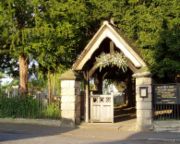
[ 3] :
Numerous footpaths start at the village boundary (often as the continuation of a street or gitty) and lead over the fields to neighbouring villages, hamlets and farms.
OS = Ordnance Survey
.
OS sheets use Roman numerals
, so L = 50.
This list is incomplete.
Derbyshire
Derbyshire is a county in the East Midlands of England. A substantial portion of the Peak District National Park lies within Derbyshire. The northern part of Derbyshire overlaps with the Pennines, a famous chain of hills and mountains. The county contains within its boundary of approx...
, England. It is almost contiguous with the village of Borrowash
Borrowash
Borrowash is a village in the Erewash district of Derbyshire, England, situated immediately east of the Derby city boundary.-Amenities:In the village there is a Co-operative supermarket, which is located amongst a number of shops including a butcher, a building society agency, an insurance...
, the two only separated by the A52. Ockbrook lies about 5 miles (8 km) east of Derby
Derby
Derby , is a city and unitary authority in the East Midlands region of England. It lies upon the banks of the River Derwent and is located in the south of the ceremonial county of Derbyshire. In the 2001 census, the population of the city was 233,700, whilst that of the Derby Urban Area was 229,407...
.
History
There is evidence of human activity in Ockbrook as far back as 10000 BC (the MesolithicMesolithic
The Mesolithic is an archaeological concept used to refer to certain groups of archaeological cultures defined as falling between the Paleolithic and the Neolithic....
) in the form of two bifacial cores of flint. A small greenstone
Greenstone (archaeology)
Greenstone is a common generic term for valuable, green-hued minerals and metamorphosed igneous rocks and stones, that were used in the fashioning of hardstone carvings such as jewelry, statuettes, ritual tools, and various other artefacts in early cultures...
axe head attests to Neolithic
Neolithic
The Neolithic Age, Era, or Period, or New Stone Age, was a period in the development of human technology, beginning about 9500 BC in some parts of the Middle East, and later in other parts of the world. It is traditionally considered as the last part of the Stone Age...
activity. There is no direct evidence from the Bronze Age
Bronze Age
The Bronze Age is a period characterized by the use of copper and its alloy bronze as the chief hard materials in the manufacture of some implements and weapons. Chronologically, it stands between the Stone Age and Iron Age...
From the Iron Age
Iron Age
The Iron Age is the archaeological period generally occurring after the Bronze Age, marked by the prevalent use of iron. The early period of the age is characterized by the widespread use of iron or steel. The adoption of such material coincided with other changes in society, including differing...
there is a variety of evidence obtained during the excavation of a Romano-British
Romano-British
Romano-British culture describes the culture that arose in Britain under the Roman Empire following the Roman conquest of AD 43 and the creation of the province of Britannia. It arose as a fusion of the imported Roman culture with that of the indigenous Britons, a people of Celtic language and...
aisled building at Littlehay Grange Farm between 1994 and 1997. This includes sherd
Sherd
In archaeology, a sherd is commonly a historic or prehistoric fragment of pottery, although the term is occasionally used to refer to fragments of stone and glass vessels as well....
s of Ancaster Breedon scored ware and Aylesford-Swarling Pottery
Aylesford-Swarling Pottery
Aylesford-Swarling pottery is part of a tradition of wheel-thrown pottery distributed around Kent, Essex, Hertfordshire and Bedfordshire and named after two cemeteries in Kent dating to the 1st century BC...
, a Group A one-piece brooch, an Iron Age coin of silver dating to between 40 BC and 10 AD, and an Iron Age ring headed pin or spike
Evidence of occupation during the Roman period includes the sites of three farmsteads, one of which has been excavated. From these it appears that the fortunes of the area at that time mirrored those of nearby Derventio
Derventio (Little Chester)
Derventio was a small town in the Roman province of Britannia. Today it is known as Little Chester, on the outskirts of Derby, located in the English county of Derbyshire.-Description:...
(Roman Derby), with a boom starting during the 2nd century AD followed by abandonment at the end of the 4th century
During the early Dark Ages, Ockbrook was part of the Kingdom of Mercia
Mercia
Mercia was one of the kingdoms of the Anglo-Saxon Heptarchy. It was centred on the valley of the River Trent and its tributaries in the region now known as the English Midlands...
. According to the Anglo-Saxon Chronicle
Anglo-Saxon Chronicle
The Anglo-Saxon Chronicle is a collection of annals in Old English chronicling the history of the Anglo-Saxons. The original manuscript of the Chronicle was created late in the 9th century, probably in Wessex, during the reign of Alfred the Great...
, this was founded in 560 by Creoda
Creoda of Mercia
Creoda was the first monarch of Mercia, reigning from 584 to 593.Creoda is recorded as having been the son of Cynewald, the grandson of Cnebba, and the great-grandson of Icel; consequently, members of the Mercian royal line were known as Iclingas...
, one of who’s followers may have had the personal name Occa
It was this Occa (an Anglo Saxon
Anglo-Saxons
Anglo-Saxon is a term used by historians to designate the Germanic tribes who invaded and settled the south and east of Great Britain beginning in the early 5th century AD, and the period from their creation of the English nation to the Norman conquest. The Anglo-Saxon Era denotes the period of...
) who established Ockbrook in the 6th century on the banks of a small stream, the Ock
During the ninth century, the Danes invaded and swept through large swathes of England until fought to a standstill by Alfred the Great
Alfred the Great
Alfred the Great was King of Wessex from 871 to 899.Alfred is noted for his defence of the Anglo-Saxon kingdoms of southern England against the Vikings, becoming the only English monarch still to be accorded the epithet "the Great". Alfred was the first King of the West Saxons to style himself...
. The country was partitioned as a consequence c874 and Ockbrook, being east of Watling Street
Watling Street
Watling Street is the name given to an ancient trackway in England and Wales that was first used by the Britons mainly between the modern cities of Canterbury and St Albans. The Romans later paved the route, part of which is identified on the Antonine Itinerary as Iter III: "Item a Londinio ad...
(the present day A5) would have been in the Danelaw
Danelaw
The Danelaw, as recorded in the Anglo-Saxon Chronicle , is a historical name given to the part of England in which the laws of the "Danes" held sway and dominated those of the Anglo-Saxons. It is contrasted with "West Saxon law" and "Mercian law". The term has been extended by modern historians to...
. This period is attested to by two place names, The Ridings and Carrhill, which derive from Danish. Despite frequent skirmishes between Danes and the English hereabouts, the Danelaw survived until 1066 when, according to the Domesday Book
Domesday Book
Domesday Book , now held at The National Archives, Kew, Richmond upon Thames in South West London, is the record of the great survey of much of England and parts of Wales completed in 1086...
, the manor was held by Toki
Toki
Toki can refer to:People* The Toki clan, a Japanese samurai clan* Tōki Susumu, Japanese sumo wrestlerFictional characters* Toki, the second of the four brothers of Hokuto Shinken in Fist of the North Star...
(probably a Dane)
"...In Ockbrook Tochi had four carucates of land (assessed) to the geld, land for four ploughs. There are now ten villeins and two Bordars having three ploughs and four rent paying tenants rendering 14 shillings. There are five acres of meadow, woodland for pannagePannagePannage is the practice of turning out domestic pigs in a wood or forest, in order that they may feed on fallen acorns, beechmast, chestnuts or other nuts. Historically, it was a right or privilege granted to local people on common land or in royal forests...
one leagueLeague (unit)A league is a unit of length . It was long common in Europe and Latin America, but it is no longer an official unit in any nation. The league originally referred to the distance a person or a horse could walk in an hour...
in length and half a league wide. In King EdwardEdward the ConfessorEdward the Confessor also known as St. Edward the Confessor , son of Æthelred the Unready and Emma of Normandy, was one of the last Anglo-Saxon kings of England and is usually regarded as the last king of the House of Wessex, ruling from 1042 to 1066....
’s day worth £4 now 40 shillings belonging to the Bishop of ChesterBishop of ChesterThe Bishop of Chester is the Ordinary of the Church of England Diocese of Chester in the Province of York.The diocese expands across most of the historic county boundaries of Cheshire, including the Wirral Peninsula and has its see in the City of Chester where the seat is located at the Cathedral...
..."[ 4] .
By 1086 the manor had been transferred either to the extensive holdings of Geoffrey Alselin or to the Bishop of Chester (according to Domesday), both of whom were Norman
Normans
The Normans were the people who gave their name to Normandy, a region in northern France. They were descended from Norse Viking conquerors of the territory and the native population of Frankish and Gallo-Roman stock...
. c1130 it was divided between two sons of Sir Ralph Halselin whence half descended to the Bardolfs
William 4th Lord Bardolf
William Bardolf, 4th Baron Bardolf, of Wormegay, Norfolk was an extensive landowner in Norfolk, Lincolnshire, Suffolk and Surrey. In 1382 Bardolf had livery of his lands from the Crown...
of Wormegay
Wormegay
Wormegay is a civil parish in the English county of Norfolk. The village is situated some south of King's Lynn and west of Norwich.It covers an area of and had a population of 339 in 141 households as of the 2001 census....
(who sold it to the Foljambe's c1420) and half to Serlo de Grendon who granted it to Dale Abbey
Dale Abbey
Dale Abbey is a village and civil parish in the borough of Erewash in Derbyshire in the East Midlands of England, 6 miles north east of Derby....
. At the Reformation
English Reformation
The English Reformation was the series of events in 16th-century England by which the Church of England broke away from the authority of the Pope and the Roman Catholic Church....
, these shares were largely broken up amongst the freeholders, notably the Battelles, Harpurs, Keyes
Keyes
Keyes is a common surname. It may refer to several notable people:* Alan Keyes , American politician and diplomat* Carlito Keyes, fictional character* Charles Henry Keyes , American educator...
(of Hopwell) and Wilmots (of Chaddesden
Chaddesden
Chaddesden, also known locally as Chad, is a large suburb of Derby, United Kingdom, formerly known as Cedesdene.-Cedesene village:The old village of Cedesene is situated two and a half miles east of the city...
)
In 1750 the Moravian Church established a settlement here, one of only three remaining in the country. This was on the edge of the old village and separate from it. The buildings are Georgian red brick and two of them, the Manse (1822) and the Chapel (1751–1752) are grade II listed
From the early 19th century, middle-class families from Derby and Long Eaton
Long Eaton
Long Eaton is a town in Derbyshire, England. It lies just north of the River Trent about southwest of Nottingham and is part of the Nottingham Urban Area...
took advantage of the fragmented landowning pattern to acquire land and build elegant villas
In more recent times, extensive new housing developments have turned Ockbrook into a commuter dormitory for Derby.
Area and population growth
The area of the village is 1730 acres (700.1 ha)The population growth figures include Borrowash
Borrowash
Borrowash is a village in the Erewash district of Derbyshire, England, situated immediately east of the Derby city boundary.-Amenities:In the village there is a Co-operative supermarket, which is located amongst a number of shops including a butcher, a building society agency, an insurance...
and are taken from

| 1801 | 1811 | 1821 | 1831 | 1841 | 1851 | 1861 | 1871 | 1881 | 1891 |
| 827 | 934 | 1203 | 1634 | 1765 | 1763 | 1506 | 1633 | 1938 | 2166 |
| 1901 | 1911 | 1921 | 1931 | 1941 | 1951 | 1961 | 1971 | 1981 | 1991 |
| 2567 | 2807 | 2969 | 2971 | 3373 | 3775 | 5278 | 7107 | 7436 | 7092 |
| 2001 | |||||||||
| 7331 |
Schools
- Ockbrook Ridings Playgroup
- Redhill Primary School
- Ockbrook SchoolOckbrook SchoolOckbrook School is an Independent School located in the village of Ockbrook on the outskirts of Derby. The school admits both day pupils and boarders....
Churches

- All Saints' Church, OckbrookAll Saints' Church, OckbrookAll Saints' Church, Ockbrook is a parish church in the Church of England located in Ockbrook, Derbyshire.-History:Before the English Reformation, Ockbrook was a chapelry within the parish of Elvaston, cared for by a curate...
became the parish churchParish churchA parish church , in Christianity, is the church which acts as the religious centre of a parish, the basic administrative unit of episcopal churches....
between c1550[ 5] and c1600[ 2] . Prior to this it was a chapelry of ElvastonElvaston, DerbyshireElvaston is a small village and civil parish in Derbyshire, England. The parish also includes two other hamlets, Ambaston and Thulston, and a recently built housing estate Boulton Moor...
[ 2] . The fontBaptismal fontA baptismal font is an article of church furniture or a fixture used for the baptism of children and adults.-Aspersion and affusion fonts:...
is SaxonAnglo-Saxon architectureAnglo-Saxon architecture was a period in the history of architecture in England, and parts of Wales, from the mid-5th century until the Norman Conquest of 1066. Anglo-Saxon secular buildings in Britain were generally simple, constructed mainly using timber with thatch for roofing...
or NormanNorman architectureAbout|Romanesque architecture, primarily English|other buildings in Normandy|Architecture of Normandy.File:Durham Cathedral. Nave by James Valentine c.1890.jpg|thumb|200px|The nave of Durham Cathedral demonstrates the characteristic round arched style, though use of shallow pointed arches above the...
[ 5] , the tower is late twelfth century, the broached spire is thirteenth century[ 1] and the oak chancel screen dates from c1520[ 5] . Recent historical research and archaeological finds suggest that it may originally have been a PaganPaganismPaganism is a blanket term, typically used to refer to non-Abrahamic, indigenous polytheistic religious traditions....
religious site[ 5] . - Moravian
Pubs
- Cross Keys. Still has a knitters window where stockings were made for Queen Victoria and her courtNoble courtThe court of a monarch, or at some periods an important nobleman, is a term for the extended household and all those who regularly attended on the ruler or central figure...
[ 2] . - Queens Head.
- Royal Oak. Ockbrook's oldest pub, it was held by the Peet family for the three hundred years from ~1610 to 1912, a remarkable record
[ 1] . Beer was once brewed here, using water from the pub's own well, now capped by a stone slab near the front door[ 5] . - White Swan. Situated opposite All Saints church on Church Street.
Amenities
- Hill Top Service Station
- Garden Shoppe
- Ockbrook News
Streets, gittys and footpaths
This list of streets is taken from- Anne Potter Close
- Bakehouse Lane
- Bare Lane - See note below
- Cedar Drive
- Church Street
- Cole Lane
- Collier Lane
- Collumbell Avenue
- Croft Close
- Far Lane: The ancient hedgerows along its upper reaches indicate that this is a very old track, probably dating from the Mesolithic. It is possible that it once connected with the Port-ways i.e. the rivers DerwentRiver Derwent, DerbyshireThe Derwent is a river in the county of Derbyshire, England. It is 66 miles long and is a tributary of the River Trent which it joins south of Derby. For half its course, the river flows through the Peak District....
and TrentRiver TrentThe River Trent is one of the major rivers of England. Its source is in Staffordshire on the southern edge of Biddulph Moor. It flows through the Midlands until it joins the River Ouse at Trent Falls to form the Humber Estuary, which empties into the North Sea below Hull and Immingham.The Trent...
[ 5] . - Flood Street
- Green Lane - See note below
- Hargrave Avenue
- Hill Croft Drive
- Homefarm Close
- Moor Lane - See note below
- New Street
- Orchard Close
- Pares Way
- Ryal Close
- Shop Stones
- Sisters Lane
- The Paddock
- The Ridings: The name is Danish either for a clearing or a similar sounding word meaning a third division
[ 5] . - The Settlement
- Top Manor Close
- Victoria Avenue
- Wesley Lane
- Windmill Close
- Yew Tree Avenue
- Note - Bare Lane, Green Lane and Moor Lane form one continuous road through the village.
The quickest route between two points in the village is often via a gitty. These were originally footpaths through fields. They have survived the encroachment of housing by mutating into high walled or fenced alleyways between the buildings and gardens of the new (and old) developments. |
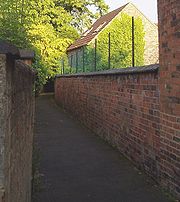 |
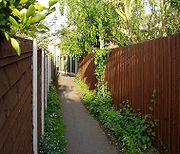 |
Numerous footpaths start at the village boundary (often as the continuation of a street or gitty) and lead over the fields to neighbouring villages, hamlets and farms.
Historic maps (in chronological order)
|
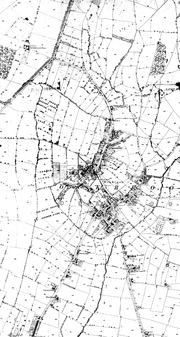 |
|
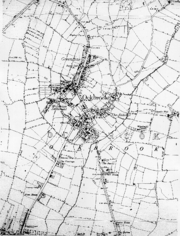 |
|
|
|
|
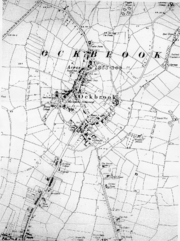 |
|
|
|
|
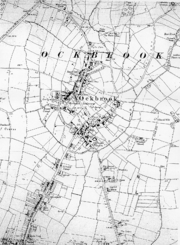 |
|
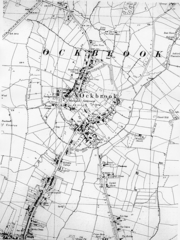 |
|
|
OS = Ordnance Survey
Ordnance Survey
Ordnance Survey , an executive agency and non-ministerial government department of the Government of the United Kingdom, is the national mapping agency for Great Britain, producing maps of Great Britain , and one of the world's largest producers of maps.The name reflects its creation together with...
.
OS sheets use Roman numerals
Roman numerals
The numeral system of ancient Rome, or Roman numerals, uses combinations of letters from the Latin alphabet to signify values. The numbers 1 to 10 can be expressed in Roman numerals as:...
, so L = 50.
This list is incomplete.
Further reading
- A French Parson at Ockbrook, Marion Johnson, M. Johnson, 31 October 2001, ISBN 1-873064-09-8.
- A history of All Saints' Church, Ockbrook: including a brief account of the early origins of the village and parish, J W Harnan, J W Harnan, 1971, ISBN 0-9502209-0-6.
- Bold Shall I Stand: The Education of Young Women in the Moravian Settlement at Ockbrook Since 1799, James Muckle, Ockbrook School, September 1999, ISBN 0-9536600-0-1.
- History Of The Moravian Church, J. E. Hutton, R A Kessinger Publishing Co, 17 June 2004 ISBN 1-4191-2425-0. See references to Ockbrook at http://www.amazon.co.uk/gp/reader/1419124250?v=search-inside&keywords=Ockbrook.
- Lords of the Manor of Ockbrook: Archives 1583 to 1605 (Ockbrook & Borrowash Record S.), Marion Johnson, Greenway Publishing, 11 April 1994, ISBN 1-873064-06-3.
- More Memories of Ockbrook and Borrowash (pamphlet), Marion Johnson, M. Johnson, 20 October 1991, ISBN 1-873064-04-7.
- Ockbrook and Its Parson Samuel Hey 1810-52, Marion Johnson, M. Johnson, 1 March 1991, ISBN 1-873064-02-0.
- Ockbrook in Old Picture Postcards, J. Lec Smith, Europese Bibliotheek B.V., Uitgeverij Boekhandel Antiquariaat, February 1985, ISBN 90-288-2983-0.
- Ockbrook in the 1820s (pamphlet), Marion Johnson, M. Johnson, 31 July 1991, ISBN 1-873064-03-9.
- The Plumpton Letters and Papers (Camden Fifth S.), Joan Kirby (Editor), Cambridge University Press, 16 January 1997, ISBN 0-521-57394-7. See references to Ockbrook at http://www.amazon.co.uk/gp/reader/0521573947?v=search-inside&keywords=Ockbrook.
- Yeomen of Elizabethan Ockbrook: Archives of the Sixteenth Century (Ockbrook & Borrowash Record S.), Marion Johnson, Greenway Publishing, 11 April 1994, ISBN 1-873064-05-5.

